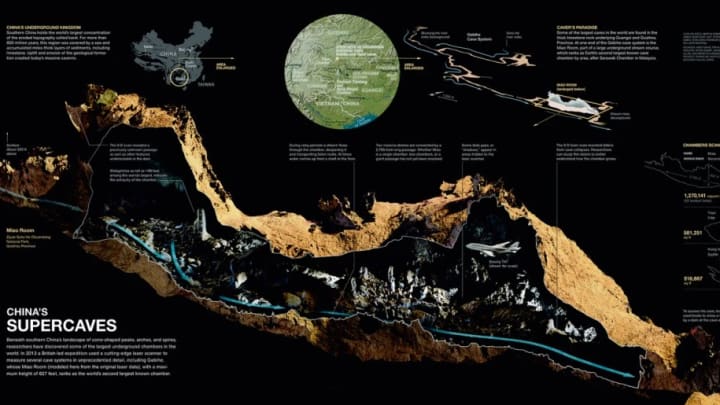9 Fact-Packed Infographics From National Geographic's Archives

A new book collects the best information design from the magazine's 128 years in print.
National Geographic is one of the oldest magazines still in print in the U.S., and its archives are a deep well of great illustrations. When the magazine was founded in 1888, there were no photos to accompany its articles or explain the concepts inside. Instead, there were charts and graphs.
“The magazine is the ultimate reference for maps, charts, and diagrams that explain everything about Earth and space. (And much more besides),” information designer Nigel Holmes writes in a new book called National Geographic Infographics ($70 from TASCHEN). The hefty book collects some of the best of the magazine’s 128 years of infographics. Here are just a few of the best ones.
1. SUPERCAVES
NatGeo funded an extensive surveying and mapping project in the Carlsbad Caverns in New Mexico in the 20th century, publishing the first color photographs of the caves in 1953 and the first maps of the underground network’s depth and breadth. It’s safe to say that the magazine is pretty invested in its cave coverage. In July 2014, it published this model of caves under southern China, measured with laser scanners in 2013.
2. WORLD FLOWERS
This 1968 map shows where 117 flowers originated in the world, before explorers brought bulbs and seeds to and from far-off places. The flowers we associate most with a region aren’t necessarily native, as you’ll see. Tulips, famous for dotting the Dutch countryside, are actually from Turkey.
3. HUNTING ORCAS
In 2015, illustrator Fernando Baptista designed this infographic about the hunting methods of orcas, exploring their techniques and how they cooperate with the rest of their pod.
4. SLEEP SECRETS
Just where does sleep happen in the brain? A whole bunch of regions, as you can see in this illustration. This infographic is from the May 2010 issue.
5. KILLER CANCERS
Not all cancers are alike. Some, like colorectal or breast cancer, are now easier to detect and treat thanks to better screening, while others, like liver cancer, are still fatally hard to catch early. This 2011 infographic shows how different death rates for different cancers are in the U.S.
6. THE EVOLUTION OF AIRPLANES
Air travel has changed vastly over the last century. The planes shown in this image represent major breakthroughs in plane engineering, from the first sustained flight by the Wright Flyer to the Concorde’s ability to go twice as fast as the speed of sound.
7. COLUMBIA’S SPACELAB
Most people are familiar with the sight of a space shuttle from the outside, but few get to go inside one. This graphic shows the inside of the space shuttle Columbia’s Spacelab. The lab module fit inside the shuttle and was first launched in 1983 for a 10-day mission designed to prove that scientific research in space was possible. In other words, it paved the way for the kind of experiments now conducted on the International Space Station. (Columbia broke apart after re-entry following its 28th mission in 2003, killing all seven astronauts on board. The space shuttle program was discontinued in 2011.)
7. SKI HISTORY
National Geographic was writing about skiing before it even became an Olympic event, documenting the sport as early as 1920. In December 2013, it traced the history of the humble ski in its pages.
9. NATIONAL GEOGRAPHIC EXPEDITIONS
The National Geographic Society took its first expedition in 1890, setting out for Alaska. In 1963, it mapped all 201 of its expeditions up to that time, celebrating 75 years of exploring land, sea, and sky.
The book is $65 on Amazon.